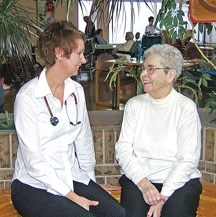A new medical facility in Okotoks aims to provide more patients with primary health care and reduce emergency room wait times.
Located at 40 Elizabeth Street, the Sheep River Nurse Practitioner Clinic, which opened in October, is the first of its kind in Alberta.
“This is huge,” said Donna Clare, president of Alberta’s Nurse Practitioner Association. “There’s definitely not enough medical clinics so this is a way to improve access… It’s a great solution.”
What sets a nurse practitioner clinic apart from other medical facilities is it is run entirely by nurse practitioners, not physicians.
A nurse practitioner is a registered nurse who has a master’s degree and some additional training enabling them to diagnose common medical conditions, order and interpret lab tests, and even prescribe some medication.
When patients enter an NP clinic, Clare said they are first screened to ensure their medical concern is appropriate for NP care.
“If they are really sick or have a complicated case, they are not typical NP patients. Those would be better handled by a physician,” she said.
The NP clinic in Okotoks operates alongside the Sheep River Medical Clinic and even shares its waiting room so access to physicians is always nearby.
However, Clare said NPs have the ability to take care of about 80 per cent of the patients who come to a medical clinic.
She said NPs can help patients with a variety of chronic medical conditions, including diabetes, hypertension, high cholesterol and asthma. They are also equipped to help patients who are obese or those who want to quit smoking.
“Those medical conditions are something that NPs do very well because we offer support and learning,” Clare said. “We spend time with patients so that they understand their disease and we teach them how to adapt their lifestyle.”
Clare said the style of health care at an NP clinic is a little different from what is provided at a regular medical clinic.
“We take a holistic approach to treating diseases rather than just tossing a pill at them,” she said.
Building long-term relationships with their patients is a specialty of NPs, Clare said.
“None of these diseases are managed in a day,” she said. “It’s that long-term follow-through and the relationship that nurses like to build with their patients that really makes this kind of care beneficial.”
While patients at a regular medical clinic are often asked to bring only one problem per visit, NP clinics welcome visitors to discuss more than one medical issue in a given appointment, Clare said.
“We don’t bill per problem so you can certainly bring up more than one problem,” Clare said.
Clare said the major benefit of NP clinics is their ability to provide more Albertans with a primary health care provider and, as a result, reduce emergency room usage — an ideal solution to a provincial health care system facing some tough questions from critics in recent weeks.
According to Statistics Canada, more than 24 million Canadians did not have a regular family doctor in 2009. Of that number, 2.4 million Albertans said they did not have a regular family doctor, the fourth highest number in the country after Ontario, Quebec and B.C.
A Dec. 6 report from the Fraser Institute also found Albertans wait an average of 22.1 weeks, nearly a month longer than most other Canadians, for non-emergency surgery.
“(There is a need to) improve access because so many people don’t have a health care provider, and doctors are already maxed out,” Clare said. “If we can follow up and take care of patients in the community, then hopefully they can stay out of the emergency room.”
However, Clare said there aren’t any immediate plans to open more NP clinics in Alberta because funding is a major hurdle, she said.
“NPs are the only regulated health care provider in the province who have no pocket of funding,” Clare explained. “We have no money allotted to us. That’s why we’re not being hired in a big way.”
Clare said the NP clinic in Okotoks, which is costly to operate, receives its funding from the Calgary Rural Primary Care Network’s capital budget.
Regular medical clinics that choose to hire NPs also have to pay their salaries out of their clinic’s budget.
Elsewhere in Canada, NP clinics are not a new phenomenon. In Ontario alone, 25 new NP clinics have been created since 2007.




